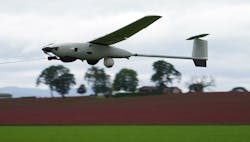Trillium to provide cooled mid-wave infrared (MWIR) electro-optical sensors for Lockheed Stalker small UAVs
PALMDALE, Calif. – Unmanned aerial vehicle (UAV) designers at the Lockheed Martin Corp. Skunk Works segment in Palmdale, Calif., needed electro-optical sensors for the company's Stalker XE small silent unmanned aircraft. They found their solution from Trillium Engineering LLC in Hood River, Ore.
Trillium will provide the company's HD55 UAV sensor payload for the Lockheed Martin Stalker. The HD55 is designed for Group 2 or smaller UAVs. It uses cooled mid-wave infrared (MWIR) cameras and onboard image processor packaged in a gimbal that measures 5.5 inches in diameter and weighs slightly less than four pounds.
The bungee-launched Stalker UAV weighs 24 pounds, has a 12-foot wingspan, can fly for as long as eight hours, at speeds as fast as 45 miles per hour, at altitudes as high as 12,000 feet, and can carry payloads as heavy as 5.5 pounds.
Optionally powered by a ruggedized solid oxide fuel cell, stalker XE runs on propane, and can be reconfigured in the field to a battery-powered option that provides four hours of endurance. The system also has been upgraded with a vertical take-off and landing capability.
Related: Sensor payloads for unmanned vehicles
The Trillium HD55 electro-optical UAV sensor payload replaces the company's HD50, which came in four configurations and first was delivered in 2014.
The HD55 has the same swept volume as its predecessor but is slightly lighter and more capable to enable the new system to get a closer, more actionable look at targets, says Trillium President Rob Gilchrist.
Trillium personnel started flight testing the HD55 last May on small UAVs and on a manned Cessna light aircraft. The small UAV sensor payload is for intelligence of visible-light and infrared video, as well as target location.
Trillium also is introducing a new configuration of the HD55 sensor payload that comes in a 5.5-inch gimbal, weighs slightly more than three pounds, has a visible-light camera, and continue-zoom midwave IR camera.
Future plans also include integrating the sensor with a new video processor, camera stabilization, target tracking, new camera interfaces, H.265-standard data encryption, and ability to transmit video and sensor command and control information over the Internet.
For more information contact Trillium Engineering online at https://trilliumeng.com, or Lockheed Martin Skunk Works at www.lockheedmartin.com.

John Keller | Editor-in-Chief
John Keller is the Editor-in-Chief, Military & Aerospace Electronics Magazine--provides extensive coverage and analysis of enabling electronics and optoelectronic technologies in military, space and commercial aviation applications. John has been a member of the Military & Aerospace Electronics staff since 1989 and chief editor since 1995.

